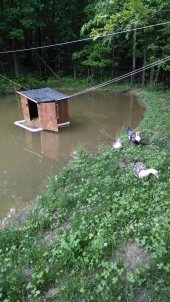




http://notquitethereyethomestead.blogspot.com/ --On the highway going from here to there the question is oft asked "are we there yet". The oft given answer is "not quite yet". So it goes with life and with my little piece of it. This is my story. I get to tell it my way. I hope you enjoy it.




Outdoor and Ecological articles (sporadic Mondays) at http://blog.dxlogan.com/ and my main site is found at http://www.dxlogan.com/




 ) is a good sized plot and you can do a lot with it. I think with the right crops you could achieve 70-80% of your fruit and veg needs once things are mature. You can easily be self sufficient in eggs and the extent that you'll meet your meat needs depends on how much you eat and whether you fancy eating other stuff from time to time.
) is a good sized plot and you can do a lot with it. I think with the right crops you could achieve 70-80% of your fruit and veg needs once things are mature. You can easily be self sufficient in eggs and the extent that you'll meet your meat needs depends on how much you eat and whether you fancy eating other stuff from time to time.


Carl Legge, author The Permaculture Kitchen
www.carllegge.com





http://notquitethereyethomestead.blogspot.com/ --On the highway going from here to there the question is oft asked "are we there yet". The oft given answer is "not quite yet". So it goes with life and with my little piece of it. This is my story. I get to tell it my way. I hope you enjoy it.
 3
3




Tina Paxton wrote:
4. Food Preservation: this is definitely an important link in the chain. I like the idea of fermenting foods and am working on developing those skills. Canning is something my elderly mother helps with when she is able. I also want to build a smoker and smoker foods. Dehydrating can be a problem with the high humidity leading to mold. Do you favor a particular method of fermenting (lacto-fermentation for example)?


Carl Legge, author The Permaculture Kitchen
www.carllegge.com




 )
)http://notquitethereyethomestead.blogspot.com/ --On the highway going from here to there the question is oft asked "are we there yet". The oft given answer is "not quite yet". So it goes with life and with my little piece of it. This is my story. I get to tell it my way. I hope you enjoy it.

|
moose poop looks like football shaped elk poop. About the size of this tiny ad:
The new permaculture playing cards kickstarter is now live!
https://www.kickstarter.com/projects/paulwheaton/garden-cards
|






